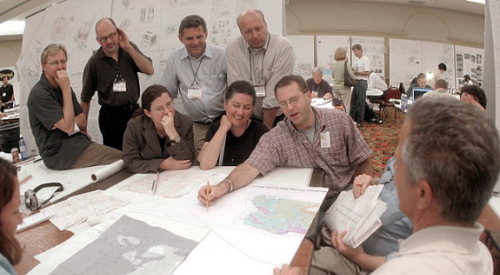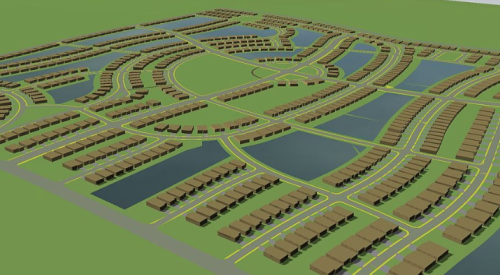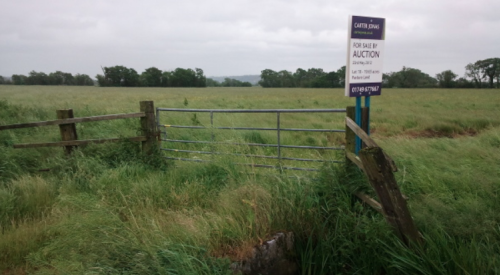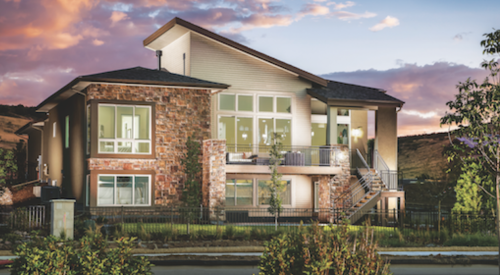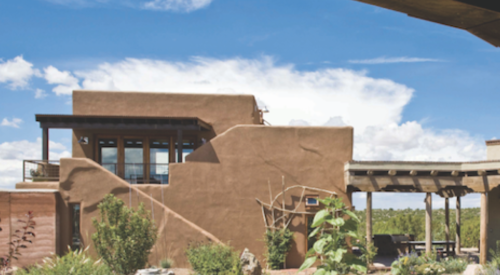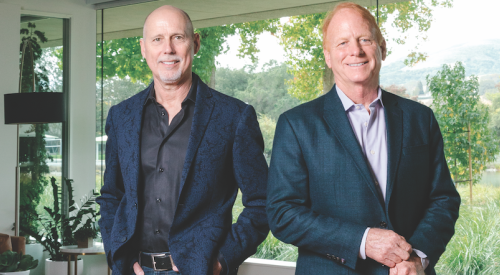| Perry Ashby (left), land planner Nick Kaufman and Missoula County Commissioner Barbara Evans embraced New Urbanist principles in championing Canyon Creek Village as part of a 400-acre, county-owned development site. Near the local airport, the larger plan calls for an office and industrial area in addition to a highway interchange that preceded everything else. These plans called for access to a key ingredient for higher-density development: a connection to the city sewer system. |
Priced from $110,000 to $135,000, the homes of Canyon Creek Village, set on 35 acres 3 miles north of Missoula, Mont., represent a huge milestone in the area’s home building life.
With a New Urbanist land plan complete with alleys, narrow streets, rear-loaded garages and a number of charming pedestrian touches, the high-density development of 254 single-family detached homes departs radically from the recent pattern of development in Missoula. So to say there was a question about how the target buyers - primarily lower-middle-income - would respond to the offering understates the risk involved for Perry Ashby of Wesmont Builders-Developers Inc.
But Canyon Creek Village was a huge success from the start. In a metropolitan area that supports only a few hundred housing starts each year, Ashby and company have built and closed more than 100 homes in less than three years. Earlier this summer, Missoula County, which originally sold Ashby the land, enthusiastically approved a similar plan for the builder/developer on an adjacent parcel suitable for 142 additional units, bringing the total community to about 400 homes when fully built out.
County Commissioner Barbara Evans says Ashby’s work marked a victory for the larger community.
"Perry cares about providing the American dream for the average guy," Evans says. "In our area, people do not want their zoning changed to increase the density. The only way you can get a denser development is if there is no one to protest. We owned the land. I wanted housing on it. And it took a long time to convince people that it was appropriate for denser housing, but ultimately, we were successful."
Since Canyon Creek Village opened, at least two other builders have started similar projects on a smaller scale and at a higher price point, Ashby notes.
Starting Over in Montana
Ashby spent 15 years in the Southern California home building business before the recession of the early 1990s caused him to look elsewhere for a place to live and work. He settled in Missoula, where in 1994 he bought and subdivided two 20-acre parcels into 5-acre, spec-house lots. Coming from the Palm Desert area of Southern California, his stock in trade was, and to a degree still is, luxury homes.
With only one or two homes under construction during the mid-’90s, Ashby devoted himself to work with the local home builders association. Word got out that he was willing to volunteer, and he found himself involved in projects such as the Parade of Homes and later became intimately involved in a local advisory group charged with suggesting revisions for outdated subdivision guidelines.
Like many municipal subdivision guidelines around the country, Missoula’s previous code rendered New Urbanist developments and TNDs illegal. Ashby and the advisory group offered local officials a set of performance-based measures with much more flexibility than the prescriptive formulas of the past. The city and county adopted a version of the guidelines that allowed New Urbanism. As a result, Ashby was honored as state Builder of the Year in 1998. The work also served as somewhat of a revelation for Ashby. It’s not often that a custom home builder catches the New Urbanism bug.
"I have done it all," Ashby says. "But my passion is in building affordable homes in traditional neighborhoods where you can bring good quality and good design and substantial square footage and tie it all together."
In 1998, Ashby tried out TND concepts at Bridge Court Village, an infill site with 29 homes. From there he was ready to test them on a larger, greenfield site. Because the concepts were so new to the development community, it was up to Ashby to do the research and bring it back to Missoula to the engineers and planners involved in Canyon Creek Village.
"It has been a great culmination," Ashby says. "I'm the one who took trips to Hidden Springs in Boise [Idaho] and to Celebration in Florida and to other projects. I paid attention to the uses on each project, whether they had live/works and multifamily together with single-family. I brought this knowledge to my consultants, and they embraced it."
In 25 years as a land planner, Nick Kaufman of WGM Group says he never had the opportunity to design a TND. He was grateful for the chance.
"I had been bugging Perry to have me as a consultant on one of his projects, so I was happy to be involved," Kaufman says. "I knew Perry had not only the vision but the tenacity to look at the long run, from the time he acquired the property through the planning and review process, to make sure it got done."
|
1990
|
A landowner donates 400 acres to Missoula County for a new highway interchange.
|
|
1990-94
|
Local officials win federal money to build the interchange and then debate about land-use decisions.
|
|
1994
|
Luxury builder Perry Ashby and his family move to Missoula from Southern California. Ashby buys several 5-acre lots and begins building luxury specs.
|
|
1995
|
Ashby meets County Commissioner Barbara Evans at a Parade of Homes.
|
|
1998
|
After years of work on an advisory panel recommending new subdivision guidelines, the city and county change their codes to allow New Urbanist development.
|
|
1998
|
Ashby builds a 29-unit, infill TND called Bridge Court Village. Its home designs become the seed for Canyon Creek Village.
|
|
1999
|
Ashby submits a proposal to build 254 homes on 35 acres within the 400-acre development site. He wins the support of Evans, who lobbies other commissioners to get the plan approved.
|
|
2000
|
Canyon Creek Village breaks ground.
|
|
2003
|
Canyon Creek completes its 96th home and three phases. Ashby also purchases an adjacent alfalfa field and wins approval for 142 additional homes as part of Canyon Creek.
|
